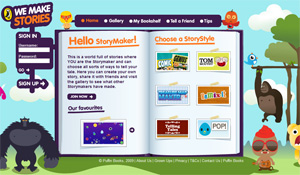 Penguin’s Puffin Books has a new membership site called We Make Stories, where kids can use an online tool to create stories. There are several types of story creation, including a remix tool to use on existing classic tales, a map maker, and a comic book style creator. It’s all drag and drop type stuff and is intended to teach creativity and encourage literacy.
Penguin’s Puffin Books has a new membership site called We Make Stories, where kids can use an online tool to create stories. There are several types of story creation, including a remix tool to use on existing classic tales, a map maker, and a comic book style creator. It’s all drag and drop type stuff and is intended to teach creativity and encourage literacy.
While this is reasonably fun-looking, I cannot understand why a site would present itself for pay membership and not really give any useful demonstration versions of its tools. There is a single demo based on remixing old stories, but this is not sufficient to make me want to offer $9.99. That price, by the way, is very effectively hidden from view and presented in a rather disturbing manner. Here’s what I mean:
1. First create a user name and password and give us your parent’s email address.
2. Your parent will then get an email asking them to pay for the membership (£5.99/$9.99).
3. Once your parent has paid this, your membership will be activated and you can start to play all the games.
Those are the instruction on the sign-up page. So kids are expected to blunder forth and sign up without the benefit of an effective demonstration. Give away a parent’s email address without permission. Then the parent receives an email demanding money. No sir. Absolutely not. You put the price in big print on the front page and you don’t mislead children into presenting their parents with an unexpected request for money. Everything should be up-front and visible right at the beginning. I just can’t believe what I’m seeing online from a major publisher. Perhaps we have here an example of how the publishing industry intends to get money out of people – by tricking their children.

 Penguin’s Puffin Books has a new membership site called
Penguin’s Puffin Books has a new membership site called